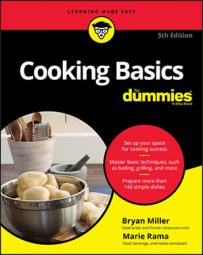Sometimes a recipe calls for parboiling vegetables. Certain dense vegetables, such as carrots, potatoes, and turnips, may be parboiled (cooked briefly in boiling water) to soften them slightly before another method finishes cooking them.
This technique guarantees that all the ingredients in the dish finish cooking at the same time. You may, for example, parboil green peppers before you stuff and bake them. Or you may parboil pieces of broccoli, carrots, and cauliflower before tossing them into a stir-fry of egg noodles and shrimp.
Blanching, or plunging vegetables or fruits into boiling water for a few seconds and then into cold water to stop the cooking process, helps cooks remove the skins from tomatoes, nectarines, and peaches. Some vegetables, like green beans, are blanched before they’re frozen or canned to help retain their color and flavor.
Steaming is the gentlest way to cook vegetables (as well as seafood). It’s also one of the most healthful because no nutrients are lost in the cooking liquids. You can steam in two ways: in a perforated steamer set over simmering water (and covered) or in a deep, covered pot or saucepan holding about 1 to 2 inches of water. The latter method works especially well for vegetables like broccoli and asparagus.
If you steam foods often, you may want to invest in some sort of steamer. The conventional steamer model is a pair of pots, the top one having a perforated bottom and a lid. You can also buy bamboo steamers or little metal steamer baskets that fit inside saucepans you already own.
When you’re ready to try cooking vegetables in water, check out these two recipes: Homemade Mashed Potatoes and Steamed Broccoli with Lemon Butter.
Something to keep in mind whenever you make mashed potatoes: Baking potatoes (like Russets, sometimes called Idaho potatoes) make fluffier, smoother mashed potatoes than “boiling” potatoes like red or yellow potatoes. Boiled potatoes contain a lot of moisture, so they get gluey when mashed, but they’re great for recipes that call for firm cubes or slices, like potato salad and gratins.
Homemade Mashed Potatoes
Preparation time: About 15 minutes
Cook time: About 20 minutes
Yield: 4 servings
4 large Idaho potatoes, about 2 pounds total
1/2 teaspoon salt
1/2 cup milk
3 tablespoons butter
Salt and black pepper
-
Peel the potatoes and cut them into quarters.
-
Place potatoes in a medium saucepan with cold water to barely cover and add the 1/2 teaspoon salt.
-
Cover and bring to a boil over high heat.
Reduce heat to medium and cook, covered, for about 15 minutes or until you can easily pierce the potatoes with a fork.
-
Drain the potatoes in a colander and then return them to the saucepan.
Shake the potatoes in the pan over low heat for 10 to 15 seconds to evaporate excess moisture, if necessary.
-
Remove the pan from the heat. Mash the potatoes a few times with a potato masher, ricer, or fork.
-
6Add the milk, butter, and salt and black pepper to taste and mash again until smooth and creamy.
Per serving: Calories 263 (From Fat 88); Fat 10g (Saturated 6g); Cholesterol 27mg; Sodium 315mg; Carbohydrate 41g (Dietary Fiber 4g); Protein 5g.
Mashed potatoes are best when mashed by hand with a potato masher or fork or when pressed through a ricer (a round, metal device with small holes through which foods are pressed). Blenders and food processors can leave them pasty.
For garlic mashed potatoes, wrap a whole, medium head of garlic in aluminum foil and roast it in a 350-degree oven for 1 hour. Remove the foil, allow the garlic to cool slightly, and then press the soft cloves to release the pulp. Mash the pulp into the potatoes with the butter and milk; then season with salt and black pepper to taste.
You can mash other cooked vegetables, such as broccoli, carrots, turnips, or sweet potatoes, and blend them into the potato mix.
Steamed Broccoli with Lemon Butter
Preparation time: About 15 minutes
Cook time: About 10 minutes
Yield: 4 servings
1 head broccoli
Salt and black pepper
3 tablespoons butter
Juice of half a lemon
-
Wash the broccoli thoroughly. Trim off the thickest part of the stems and the large leaves.
Divide the larger florets by slicing through the base of the flower and straight down through the length of the stem.
-
Place the broccoli in a 3- or 4-quart saucepan holding about 2 inches of water.
(The stalks should stand on the bottom with the florets facing up.) Add salt and black pepper to taste and cover the pan.
-
Bring to a boil over high heat and then reduce the heat to low and simmer, covered, for about 8 minutes or until the stalks are tender but not soft.
-
While the broccoli steams, melt the butter in a small saucepan and add the lemon juice. Stir to blend.
-
Using tongs, carefully remove the broccoli to a serving dish. Pour the lemon-butter sauce over the broccoli and serve.
Per serving: Calories 109 (From Fat 80); Fat 9g (Saturated 5g); Cholesterol 23mg; Sodium 176mg; Carbohydrate 6g (Dietary Fiber 3g); Protein 4g.
Trim and cut the vegetables into equal-sized pieces so they cook evenly. You can substitute vegetables like cauliflower and asparagus for the broccoli in this recipe.

